| 中文名称: | 艾塞那肽 促销 | ||||
|---|---|---|---|---|---|
| 英文名称: | Exendin-4 | ||||
| 别名: | 艾塞那肽 His-Gly-Glu-Gly-Thr-Phe-Thr-Ser-Asp-Leu-Ser-Lys-Gln-Met-Glu-Glu-Glu-Ala-Val-Arg-Leu-Phe-Ile-Glu-Trp-Leu-Lys-Asn-Gly-Gly-Pro-Ser-Ser-Gly-Ala-Pro-Pro-Pro-Ser-NH2 | ||||
| CAS No: | 141758-74-9 | 分子式: | C184H282N50O60S | 分子量: | 4186.57 |
| CAS No: | 141758-74-9 | ||||
| 分子式: | C184H282N50O60S | ||||
| 分子量: | 4186.57 | ||||
基本信息
|
产品编号: |
E10013 |
||||
|
产品名称: |
Exendin-4 |
||||
|
CAS: |
141758-74-9 |
储存条件 |
粉末 |
-20℃ |
四年 |
|
|
|
||||
|
分子式: |
溶于液体 |
-80℃ |
六个月 |
||
|
分子量 |
4186.57 |
-20℃ |
一个月 |
||
|
化学名: |
His-Gly-Glu-Gly-Thr-Phe-Thr-Ser-Asp-Leu-Ser-Lys-Gln-Met-Glu-Glu-Glu-Ala-Val-Arg-Leu-Phe-Ile-Glu-Trp-Leu-Lys-Asn-Gly-Gly-Pro-Ser-Ser-Gly-Ala-Pro-Pro-Pro-Ser-NH2 |
||||
|
Solubility (25°C): |
|||||
|
体外:
|
DMSO |
≥ 32mg/mL (7.64mM) |
|||
|
Ethanol |
< 1mg/mL (ultrasonic;warming;heat to 60°C) (insoluble) |
||||
|
Water |
33.33mg/mL (7.96mM; Need ultrasonic) |
||||
|
体内(现配现用): |
1.请依序添加每种溶剂:10% DMSO→40% PEG300→5% Tween-80→45% saline Solubility: ≥ 2.5mg/mL (0.60mM); Clear solution |
||||
|
此⽅案可获得 ≥ 2.5mg/mL (0.60mM,饱和度未知) 的澄清溶液。 以 1mL ⼯作液为例,取 100μL 25.0mg/mL 的澄清 DMSO 储备液加到 400μL PEG300 中,混合均匀;向上述体系中加⼊ 50μL Tween-80,混合均匀;然后继续加⼊ 450μL ⽣理盐⽔定容⾄ 1mL。 |
|||||
|
2.请依序添加每种溶剂:10% DMSO→90% (20% SBE-β-CD in saline) Solubility: ≥ 2.5mg/mL (0.60mM); Clear solution |
|||||
|
此⽅案可获得 ≥ 2.5mg/mL (0.60mM,饱和度未知) 的澄清溶液。 以 1mL ⼯作液为例,取 100μL 25.0mg/mL 的澄清 DMSO 储备液加到 900μL 20% 的 SBE-β-CD ⽣理盐⽔⽔溶液中,混合均匀。 |
|||||
|
3.请依序添加每种溶剂:10% DMSO→90% corn oil Solubility: ≥ 2.5mg/mL (0.60mM); Clear solution |
|||||
|
此⽅案可获得 ≥ 2.5mg/mL (0.60mM,饱和度未知) 的澄清溶液,此⽅案不适⽤于实验周期在半个⽉以上的实验。 以 1mL ⼯作液为例,取 100μL 25.0mg/mL 的澄清 DMSO 储备液加到 900μL ⽟⽶油中,混合均匀。 |
|||||
|
<1mg/ml表示微溶或不溶。 |
|||||
|
普西唐提供的所有化合物浓度为内部测试所得,实际溶液度可能与公布值有所偏差,属于正常的批间细微差异现象。 |
|||||
|
请根据产品在不同溶剂中的溶解度选择合适的溶剂配制储备液;⼀旦配成溶液,请分装保存,避免反复冻融造成的产品失效。 |
|||||
制备储备液
|
浓度
溶液体积 质量 |
1mg |
5mg |
10mg |
|
1mM |
0.2389mL |
1.1943mL |
2.3886mL |
|
5mM |
0.0478mL |
0.2389mL |
0.4777mL |
生物活性
|
产品描述 |
Exendin-4 (Exenatide) 是由 39 个氨基酸组成的多肽。它是⻓效的 glucagon-like peptide-1 受体激动剂,IC50 值为 3.22nM 。 |
|
靶点 |
IC50: 3.22nM (glucagon-like peptide-1 receptor) |
|
体外研究 |
In human umbilical vein endothelial cells, exendin-4 significantly increases NO production, endothelial NO synthase (eNOS) phosphorylation, and GTP cyclohydrolase 1 (GTPCH1) level in a dose-dependent manner. Exendin-4 shows cytotoxic effects to MCF-7 breast cancer cells with IC50 of 5μM at 48 hour. |
|
体内研究 |
Both low- and high-dose exendin-4 treatment in ob/ob mice improve serum ALT and reduce serum glucose, and calculated HOMA scores compared with control. Exendin-4-treated ob/ob mice sustain a marked reduction in the net weight gain in the final 4 weeks of the study period. Animals treated with exendin-4 have more pancreatic acinar inflammation, more pyknotic nuclei and weigh significantly less than control rats. Exendin-4 treatment is associated with lower leptin levels as well as lower HOMA values in rats. Exenatide causes dose-dependent relaxation of rat thoracic aorta, which is evoked via the GLP-1 receptor and is mediated mainly by H2S but also by NO and CO. |
推荐实验方法(仅供参考)
|
Animal Administration |
Rats: 20 Sprague-Dawley male rats, ten of which are treated with exendin-4 (10μg/kg) and ten of which are used as controls. The study period is 75 days. Serum and pancreatic tissue are removed for biochemical and histological study. Blood glucose, amylase, lipase and adipocytokines are compared between the two groups. Mice: The exendin-4 treatment groups are treated with 10μg/kg every 24 hours for the first 14 days. This treatment is the induction phase. Respective control mice (lean and ob/ob) receive saline every 24 hours. After 14 days Exendin-4-treated mice are randomly divided into two groups: one group receives high dose exendin-4 (20μg/kg) every 12 hours, while the second group continues with low dose exendin-4 (10μg/kg) every 12 hours. The control mice continue to receive saline every 12 hours. The mice are weighed daily for the 60-day treatment period. |
本计算器可帮助您计算出特定溶液中溶质的质量、溶液浓度和体积之间的关系,公式为:
质量 (g) = 浓度 (mol/L) x 体积 (L) x 分子量 (g/mol)
摩尔浓度计算公式
用本工具协助配置特定浓度的溶液,使用的计算公式为:
开始浓度 x 开始体积 = 最终浓度 x 最终体积
稀释公式
稀释公式一般简略地表示为:C1V1 = C2V2 ( 输入 输出 )








